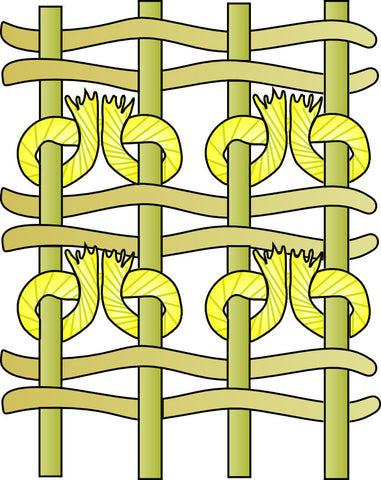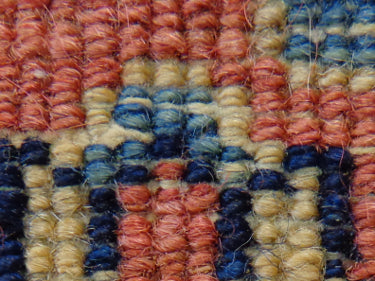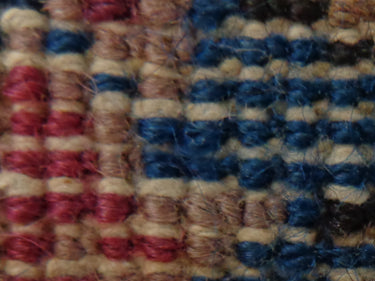Knots can be very useful guides to deciding a rugs origin and quality. Essentially there are two types, the Turkish knot (also known as Ghiordes after the name of a carpet weaving city in Turkey) and the Persian knot (also known as Sehna after the name of a carpet weaving city in Persia). The Persian knot is also known as the asymmetrical knot while the Turkish knot is known as the symmetrical knot.

Persian Rug Knot (Sehna) Original Image

Turkish Rug Knot (Giordes) Original Image
The Turkish knot is primarily used in Turkey and the Caucuses while the Persian knot is used father east in India, Pakistan and China. Iranian rugs can be woven in either Turkish or Persian knots depending on the region or on the tribal tradition of the weaver. However, Turkish and Persian knots are not used together in the same rug, as a rule, every knot in a rug is tied the same way.
Background
The foundation of a hand-knotted rug is two sets of threads: the fixed warp threads which run from north to south, and the weft threads which run from east to west separating each row of knots. Turkish knots are knotted around two warp threads while Persian knots are knotted around one warp and looped under the next in an S pattern as seen in the above photos. These knots are tied by hand. There can be between 500 and 1000 KSPI (knots per square inch) in the very finest Persian rugs. KPSI can also be referred to as knot density.
Buyers should be wary of jufti knots. These are false knots which are tied in the same way as true knots, but instead of one knot utilizing two warp threads, it utilizes four. This allows the rug to be woven in have the time because there are half the number of knots. Unfortunately this produces a coarse, loosely woven rug which will not wear nearly as well as a more densely knotted rug.
Counting Rug Knots
The warps of the rug usually lie in the same plane, and if this is the case, each knot will appear on the back of the rug as two squares of the same color next to one another from east to west on the rug

Persian Knots in a Persian Sarouk Rug

Turkish Knots in a Turkish Sparta Rug
The warps of the Persian Sarouk rug pictured above are offset. This causes the second node of the Persian knot to be hidden from the back. The photo to the right of the Persian knot shows the back of a Turkish Sparta rug. Both node elements are visible in the Turkish knots of this rug, (in this case the second element appears slightly smaller due to a minor offset). The offsetting in warps can occur with both Persian knots and Turkish knots. When both nodes are visible, they are counted as one knot. It is a common mistake to count both nodes as two separate knots.
A good general rule to follow when counting knots is: If you only see colored elements in pairs, you need to count each pair as one knot. If you see many single colored elements, the rug has offset warps and each element should be counted as one knot.
The usual practice for counting rug knots is to measure how many knots there are per square inch on the back of a rug (it is impossible to distinguish separate knots from the face of the rug). To get a more accurate measurement, you can count the knots in several different places and average the result. To count the knots, add up the number of loops or bumps within one inch vertically and horizontally on the back of the rug, then multiply them.
Knot Nomenclature
Different countries and regions use different knot nomenclature. For summaries of the nomenclature used in India, China, and Iran, see the summaries and tables below.
India:
India developed a quality rating system listed below. Two numbers are used as such; 9/9. The first number is the number of knots in 9/10 of an inch of the rugs width (east to west). The second figure is the number of knots in 4 1/2 inches of the rugs length (north to south). This is the conversion chart to knots per square inch (KPSI).
Quality KPSI (knots per square inch)
3.5/32 28
5/28 35
5/32 40
6/6 36
6/40 59
6/45 67
7/18 31
7/40 69
8/8 64
8/36 71
9/9 81
9/25 56
9/54 120
9/60 133
10/10 100
10/14 140
10/32 79
10.5/48 124
11/32 87
12/60 178
13/65 209
14/14 196
16/80 316
China:
A ruler of 12 inches is used to count the number of pairs of warps in one linear foot. Since the construction is square, you multiply the number of pairs of warps or the “line” count by itself and divide by 144 for the number of knots per square inch. For example 120 line is 120 x120 then divided by 144 or 100 knots per inch.
Line KPSI
50 17
60 25
70 34
80 44
90 56
100 69
110 84
120 100
130 117
150 156
160 180
200 278
300 625
Iran: (Persian)
Persian rugs are based on a unit of measure called “raj” or about 7 cm. Most, but not all, of the best rugs have a square knot construction or the same number of knots in both width and length. Below is a basic chart converting raj to knots per square inch.
Raj KPSI
30 118
40 210
50 329
60 473
70 675
90 1066
Sources: (Check these sources out for more information on counting rug knots and knot nomenclature!
http://www.jacobsenrugs.com/countknots.htm
http://www.igotyourrug.com/you-can-count-the-knots-although-knots-dont-count/
http://www.nejad.com/consumer/anatomy_of_a_rug.htm
Dake, https://en.wikipedia.org/wiki/File:Noeud_turc.jpg, https://en.wikipedia.org/wiki/File:Noeud_senneh.jpg
All content provided above is for informational purposes only. Neither the author nor Jessie's Oriental Rugs LLC assumes any responsibility for errors, omissions, or contrary interpretation of the subject matter. See Terms and Conditions for more information.

